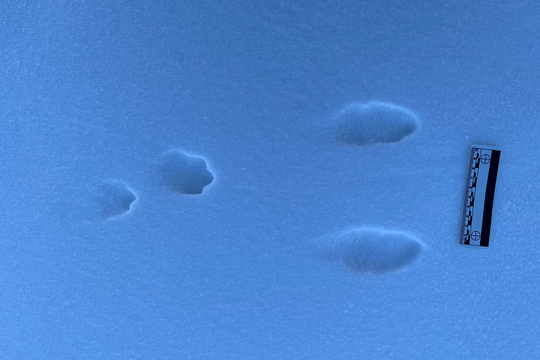Putting Yourself in Their Footprints

Tracking wildlife and connecting to the Biosphere.
The Biosphere has a way of bringing people together. At several recent tracking workshops, held in partnership with Fiera Biological Consulting, we not only brought people together, we helped people get more acquainted with some of the wildlife that also call the Beaver Hills home.
The first workshop, an online introductory session presented by Joseph Litke with Fiera, attracted more than 60 participants who discovered some of the ways of seeing tracks and learned how tracks can reveal exciting stories if only we are curious enough to ask questions and investigate.
At the subsequent in-field workshops, families from Edmonton, Beaver Hills area landowners and wildlife biologists – a diverse group – assembled at the Miquelon Lake Research Station to learn about tracking from Joseph Litke and Sage Raymond, who are both certified track and sign professionals. After a primer, the group strolled Miquelon Lake and learned to identify animal tracks.
While birdwatching is a popular pastime, especially in the Beaver Hills, mammals don’t often get the same attention. They’re harder to spot than birds and so they can be neglected in citizen science. Tracking is about more than just identifying animals by their footprints. It’s about getting curious and understanding the animal’s path – where they went, why and what they might have encountered along the way.
By becoming familiar with the various signs wildlife leave, including their tracks, workshop participants got to know the track makers, ask questions about how they got there, where they were going and why. This involves not only sight, but sound, smell and even imagination – observing everything and asking good questions. Much to participants’ delight, signs of moose, elk, deer mice, voles, coyote, grouse and even raccoon were spotted during the workshops.
"Tracking really gives people another lens through which to see the world," says Joseph Litke, Operations Director with Fiera. "Even if you just want to know the difference between the different tracks you see in your yard."
As participants got to know the creatures that call the Biosphere home, they deepened their connection to the land and its inhabitants – a connection we all desperately need.
"Accessing nature is sometimes difficult. We’re all nature deficient, we spend a lot of time on our phones and staring at screens. We put a lot of barriers between ourselves and nature," Joseph adds. "These workshops were an opportunity for people to connect with nature and put themselves in their footprints."
The Biosphere’s Executive Director, Brian Ilnicki, agrees.
"This was really a way to get people connected to the land and to the Biosphere as a whole," says Brian. "The workshops were intended to inspire greater curiosity and awareness, which in turn, will hopefully encourage participants to participate in conservation."
The Biosphere also hosted a tracking workshop for Indigenous folks to learn traditional tracking and connect with the Biosphere. In this workshop, two Indigenous facilitators, Les Skinner and Landon Delorme, offered participants the science of tracking alongside Indigenous stories and narratives.
"This has been one of the best events we’ve done to bring western science and Indigenous science together," says Bob Montgomery, Indigenous Engagement Coordinator with the Biosphere.
Many of the participants in the Indigenous workshop were young, urban professionals looking to reconnect with traditional knowledge and ways of being.
"As Indigenous people, the land is where we get our identity," adds Bob. "To reconnect with who we are as a people, it's important that we reconnect with the land, guided by people who have traditional teachings, who know creation stories, who have spent a lot of time learning from older Indigenous people and have spent a ton of time on the land."

Photo: Deer mouse tracks, interrupted by a bird. Photo by Bob Montgomery.
Comments